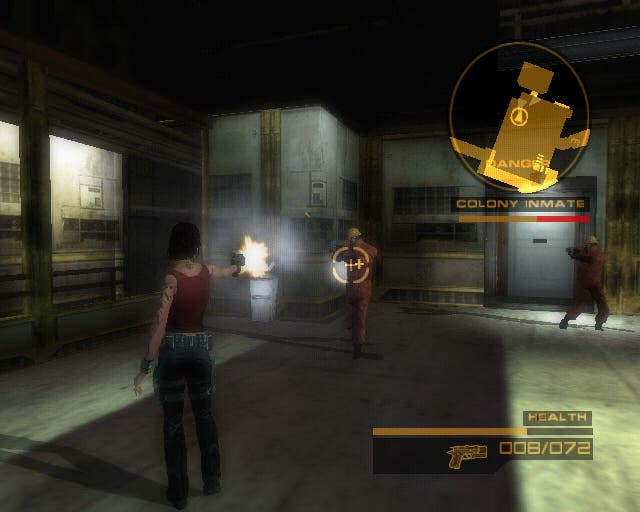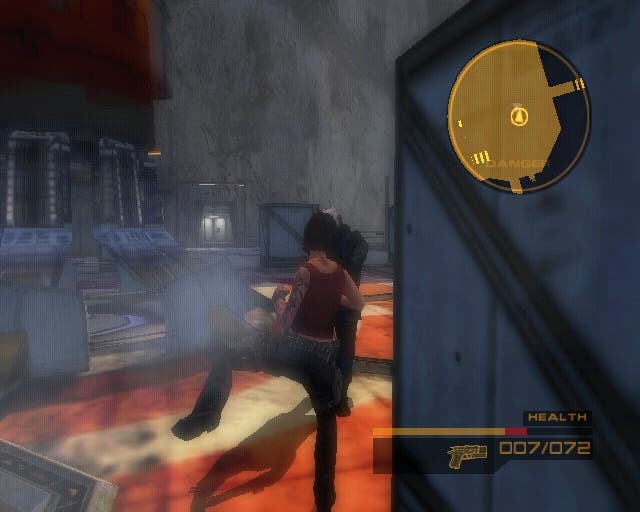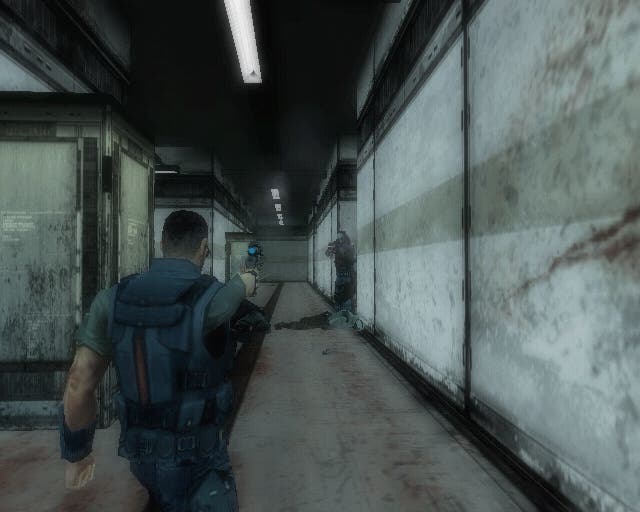Headhunter: Redemption
Maybe the sequel will be called Headhunter Redemption: Redemption.
Order yours now from Simply Games.
In a curious twist, Headhunter: Redemption, which brings us back into contact with bearded Judge Dredd-alike Jack Wade, is supposed to be set 20 years after the events of the first game. Unfortunately, after you've spent an hour or so trawling through the introductory sci-fi twaddle and the game's first level, you'll probably feel more like you've taken a step back into the past, because despite a number of significant gains in the genre over the past few years, developer Amuze hasn't learnt how to do third-person gunnery properly. Or third-person movement for that matter.
Which is odd, really, because Headhunter certainly culls a lot of ideas from elsewhere. There's a lean-up-against-the-wall-and-pop-out-to-shoot mechanic, stealth kills are in evidence (hold the left trigger down, sneak up behind an enemy and press A and he'll go down rather brutally), there's a combination scanner/map computer tool (for identifying breakable walls, locating objectives, and so on and so forth), there's a 'code breaker' (for busting down security doors, all of which seem to yield to simple join-the-dots or add-the-numbers-in-your-head style puzzles), there are little spider headcrab bastards to contend with, and there's an annoying streetwise female sidekick who spends more time on screen than our actual hero. Which is, in itself, something of a riff on Metal Gear Solid 2's character switcheroo, no?
X Marks The Plot

But let's not get ahead of ourselves. First: a little background. As we said, it's 20 years later. In the intervening years, much has happened. For a start, the population has been decimated by the Bloody Mary virus, leading to widespread unrest and lawlessness, which was only eventually suppressed by a massive earthquake that buried most of civilisation under mountains of rubble - and split society into Above (where all is good and pure) and Below (where the power comes from, and where the riffraff and criminals are sent and broken down into mindless drones). As things stand at the beginning of the game, some George W Bush impressionist is in charge up top - a surefire sign that things aren't as sweet and innocent as they seem - and Jack's former squeeze Angela Stern is now CEO of weapons-and-virtually-everything-else company Stern Industries. She's also his boss, and has all sorts of issues with him [probably the scratchy beard -Ed].
Jack has bigger problems than a vindictive ex, however. As we're shown in the intro sequence, one of his former cases has caught up with him - a young girl that he rescued from certain doom at the hands of her crazed father some years ago. She seems to have made it out of her orphanage and taken on a life of crime and dodgy tattoos, which Jack brings to an abrupt end in the traditional manner - by arresting her, spotting her necklace and realising who she is, and then press-ganging her into becoming a trainee headhunter. The result is that we start off controlling her, Ms. Leeza X (X being the unglamorous surname bestowed upon 'residents' of her orphanage), as she reluctantly ('petulantly' would be a better description) joins Jack's pursuit of a nasty terrorist organisation called The Opposition and their leader The Man Who Walks With Machines (or 'TMW3M', apparently - think about it), who, inevitably, aren't quite the wackjobs they've been hyped up to be. Control then switches between the two at intervals.
Of course, a clichéd premise alone isn't enough to sink something like this. After all, some of the best games we've ever played are built around stories that would sound a bit tired on paper. Prince of Persia, anyone? Half-Life? What makes them good is a mixture likeable characters, clever twists and solid gameplay. Unfortunately, Headhunter doesn't have these. We'll always have a soft spot for Jack, but his boss is sub-Max Payne boss woman bitch and Leeza is only likely to appeal to rebellious teenagers who hate their parents. She's a bit like gaming's John Connor, actually. As a result the story meanders along without ever becoming truly exciting. Meanwhile, you'll quickly discover that playing the game is more like going through the motions and checking a list of objective boxes. With bullets.
Fight Snub

The combat, first of all, is built around a central gun mechanic that, while it probably sounded clever at the time, ultimately frustrates far more than anything else. Despite using a computer to help with targeting, your auto-aim doesn't lock onto anything properly for a few seconds, which you generally spend cartwheeling or strafing around trying to avoid the attentions of battle-hardened but fairly dim-witted enemies. Meanwhile the aiming reticule hovers on and off the target and eventually settles, at which point you can pop off a few rounds. Whenever you or your enemy ducks behind cover though, you lose your lock-on and the process begins again, so inevitably battles take longer than they ought to, use up more ammunition than they should, and knock a few points off your health. Even more annoying is the way that you can lean up against walls and shoot round corners, kill.switch-style, but you're still exposed and forced to wait for the sights to settle when you duck out to fire, which neutralises any advantage.
Sadly, the poor weapons combat is exacerbated by a dodgy camera, squirrelly character movement, and the auto-aim's tendency to miss enemies unless they're within a certain viewing arc. Enemies on lower platforms, for example, probably won't be picked up immediately (although they'll hit you a couple of times), and you'll be forced to pirouette on the spot trying to catch them in your sights. Or you'll be left pointing hopelessly at a wall. You can adjust your aim manually to a certain extent, and switch targets by pushing the right analogue stick left or right, but that just leaves you waiting for the sights to settle again. Just as unhelpfully, the camera has a hard time working out which way to face, centring it is disorientating unless you're standing still (at which point it's redundant), and you can't invert the view controls [first Second Sight, now this - are developers trying to lose sales or what? -Ed].
Fortunately there are some alternatives. There's no hand-to-hand combat, per se, but the aforementioned stealth kills can be used every so often if your enemy isn't looking, and, if you're right in an enemy's face, clobbering the fire button sees Leeza or Jack deliver a roundhouse kick to the head, which knocks off a chunk of enemy health without wasting ammo. It's just a pity you can't fall back on these options more regularly. As it is, gun battles are a chore, and the bigger and better weapons, which surely ought to be more fun, are actually more annoying - like the sniper rifle, which is a pain to use, and contributes to particularly frustrating "protect so-and-so" missions that involve shepherding an ally past a host of the tiny, headcrab-like spiders we mentioned earlier.
Use Your Head (Or Don't)

Elsewhere the game is a mixture of simple fetch quests and puzzles, many of which rely on your scanner, which, it won't have escaped your attention, is a dead ringer for the one Samus uses in Metroid Prime. For example, in one scenario Leeza is trying to find out how to get through a door with a force field over the top of it. After looking around hopelessly for a while, you spot that a trickle of energy leads off along the wall and disappears at the end of a corridor. Scan the wall and it turns out you can break it. Plant some explosives and, er, bomb's your uncle - the machinery inside governs the force field.
What's frustrating though is that the game is inconsistent in what it will let you figure out for yourself. Working out you need to blow up a wall is encouraging, but once you go through the resulting hole, you can't target the power generator - which might as well have a sign on it saying "blow me up to continue" - until you've hit the white button to bring up your scanner, targeted the generator and held the right trigger for a few seconds to reveal that - gasp - you can blow it up. Then you come out of the scanner and your auto-aim will suddenly pick it up, allowing you to fill it full of lead.
You have to do this so many times that it surely must have dawned on the developers how laborious it becomes. Say there's a hatch covering a ladder that represents the only way to make progress - you can't target the hinges until you've scanned them. Individually. There's a creaky metal light fixture hanging on a tether, which looks like it'll smash into an adjacent, discoloured and crumbling bit of wall if you just shoot one of the joints - you can't target it until you've scanned it. There's a succession of crates being held up by metal clamp things, which obviously fall down and can then be clambered over - you have to scan them all.
What makes all of these things so depressingly obvious is that, despite sending you scouring every nook and cranny of the game's levels, there's always a very precise order to your progression, and you very rarely seem to have any doubt about the next thing you need to do - or where you need to be. Blow up three power generators? Well, they can only be hiding behind the giant, door-sized extractor fans, surely, since they're the only things we haven't gone near yet?
Head In The Clouds

But while on the one hand the game refuses to let you trust your intuition, on the other there are times when its lack of explanation almost leaves you high and dry. We didn't have a manual, sadly, but since nobody reads manuals anyway we can imagine we won't be the only people who don't realise that Leeza and Jack can jump small gaps if you run off the edge. It was only when we found that out after toiling around the very first level for near 30 minutes without a clue that we managed to get over a fence and find our way to the next checkpoint.
Then there are the logic games, played out on Leeza and Jack's IRIS computers. These aren't a bad idea; in fact, some of them are quite good. When you find a door with 130 volts written on it, you have to go back to a central computer and balance the input of power by adding and subtracting numbers in your head so that you don't over or under-load the circuits. The Daily Mail would love it - teaching our kids! But then there are other puzzles - substitution jobs, 'complete the pattern' tasks, and even the odd one that has you scrambling for pen and pad to try and figure it out - which are just tedious.
And really that's Headhunter's problem in one - the solution is usually obvious, but actually getting there is boring, and everything else about the game conspires to make it even more laborious. Climbing crates, swinging along ledges, or even walking along them is awkward. You have to pick up every enemy's dropped ammunition manually. You can't jump manually so you have to dodge utterly functionless ankle-high laser beams by waiting for moving crates to block their path. You have to scan everything, even when you know precisely what it is and does. Everything you interact with seems to hold your character's attention immovably for two or three seconds too long.
The list just goes on and on, and all your objectives, all the dialogue, even all the level graphics and sound effects are either fabulously mundane or you've seen it all before. And that's before we start probing down the list of design quirks and flaws - like the way you will always respawn at a checkpoint with full health, so it's almost always beneficial to save, get yourself killed almost immediately and then restart with a full health bar instead of frivolously making use of the precious few health packs you'll manage to pick up along the way. And the map tool where the controls are all back to front for now good or obvious reason, rendering it extremely difficult to get a handle on. And, on a grander scale, the fact that Amuze has abandoned the city-crawling of the original in favour of thrusting us into the dark, claustrophobic underbelly of society for the most part.
Losing Your Head
In fairness to Headhunter, it's not the worst third-person action game we've played this year (and it looks quite nice thanks to a visual layer that blurs out all the jagged edges and gives the game's brown, sludge-like texturing and character models a pleasant sepia-ish tint), but having played so many third-person action games it does come across, to us, as painfully average. If you're looking for something of this ilk at the moment and remember the first game fondly, then you might find it enjoyable enough, but we'd advise you try renting it first before splashing out. Otherwise, and particularly if you're a fan of the genre, we'd recommend you wait for games like Psi-Ops and Second Sight, or just investigate one of the dozens of other far better examples available on both Jack Wade's preferred platforms - the PS2 and Xbox - because for all the nice ideas it borrows, Headhunter: Redemption is still fundamentally incapable of rising Above, even if it's not quite doomed to the depths of Below either.

